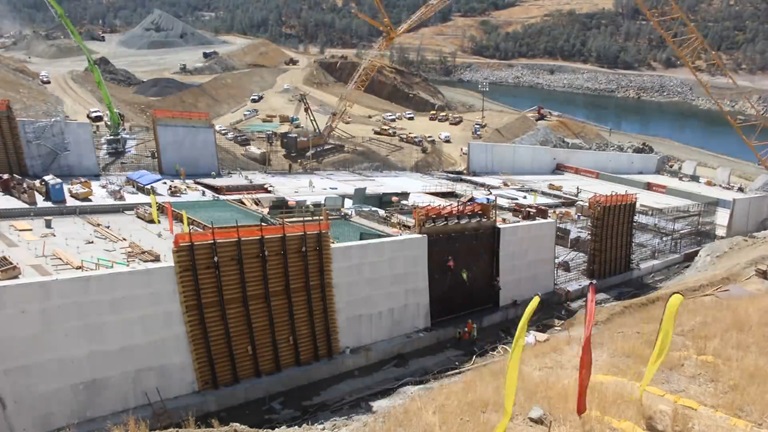Q/A with Delta Conveyance Project Executive Director Tony Meyers
Image of construction of the main Oroville spillway. 
In the first episode in the Delta Conveyance Team Spotlight video series, we spoke with the project’s Executive Director Tony Meyers about his long and eventful career in engineering, including work on some of DWR’s most ambitious and significant infrastructure projects. In this excerpt, he reflects on the appeal of large-scale engineering projects and speaks about the importance of the Delta Conveyance Project in protecting the security of California’s water supply.
DWR: Tony, I think many people would find it just overwhelming to work on projects of such scale where there's so much at stake and where you have so much responsibility. But you seem, in your career, to have thrived on those kinds of challenges. What is it about these projects, which have so many moving parts and such urgency, that you enjoy?
TONY MEYERS: I'm not quite sure other than I guess it's somewhat of a puzzle factor. You know, the more complicated the puzzle, the more interesting it is and the more fun it is to put together, and complicated projects are something that just really gets me all spun up and excited. I guess it's just a matter of testing one's resolve and whether it's capable of being done. How much can you really focus on the right thing to do rather than being worried about making a mistake? That's, I think, the key.
You know what, as I'm thinking, give me one second. I hope this doesn’t look too weird, but this is life wisdom from Coach (John) Wooden, former UCLA basketball coach, and there's a quote here that I read most every week, and it says: “You may be better than the rest, but you are not a success until you have made the effort to become the best you can be.” I think the part that really gets me excited is waking up every day and not just existing for that day but being the best I can be in that day and helping others to do the same.
DWR: So, tell us about a typical day of work for you on the Delta Conveyance Project these days.
TM: Well, there really isn't a typical day. That's a good question. There's maybe a typical month where within any given month we're tracking to make sure that the activities that are being accomplished are keeping the program on schedule. We're looking to make sure that the cash flow analysis from a monthly basis is ensuring that we're going to meet our budget criteria and our budget constraints.
We're looking to make sure that our State Water Project partners are satisfied with the work that's getting done and our questions are being answered. We're also looking at the work that the Delta Conveyance Design and Construction Authority is doing because we have such a critical oversight role on them, to ensure that the facilities that are being designed are going to meet the specifications for the State because we have long‑term ownership and operation responsibilities and we have to ensure that, long term, we have a resilient and a dependable system that we can operate effectively.
DWR: And, of course, just as you experienced back when you were a student working on the Peripheral Canal effort, there's still concern about the project which I'm sure you must encounter just in the course of your job. What do you say to people to convince them that the project is essential?
TM: The State Water Project is not a system that just benefits only a few and a special few, but it is a system that benefits the entire state of California. It runs the whole length of the state, pretty much, from Lake Oroville, south. It has 27 million people that depend for their water on this facility. It's not just Southern California. We've got North Bay constituents; we've got South Bay constituents. The whole of the computer industry and world down in Santa Clara Valley wouldn't be there without the State Water Project, and it is vital to California’s economy and to the 27 million people, of which many are in environmental justice communities, that depend on this water. It is critical that we have a system that we can depend on, that's reliable and that is sustainable through climate change and seismic rifts into the future for the next 70, 80, 100 years as we develop and continue to grow this beautiful state.
Watch the full interview.
